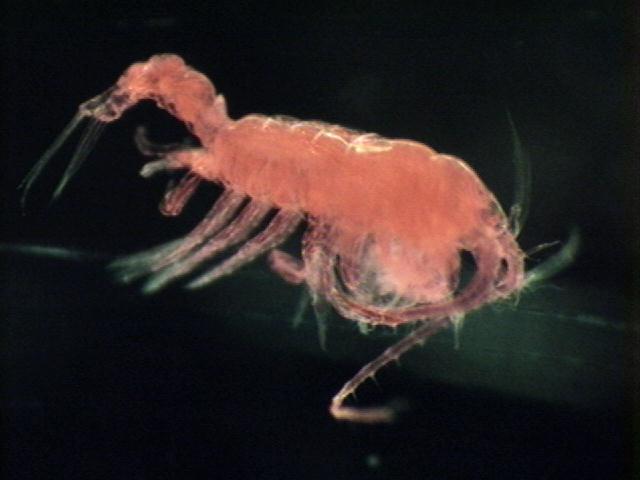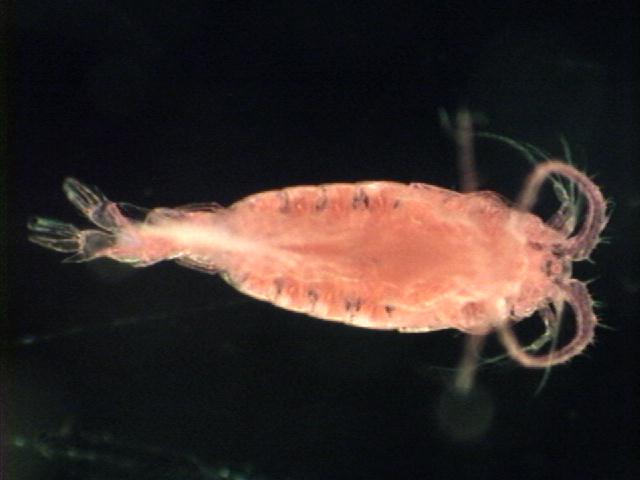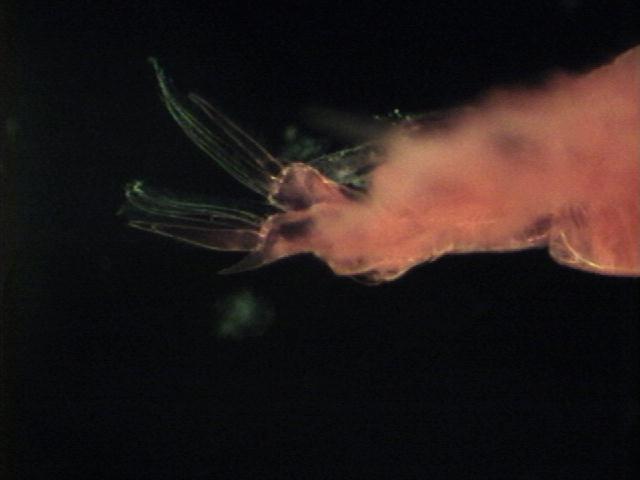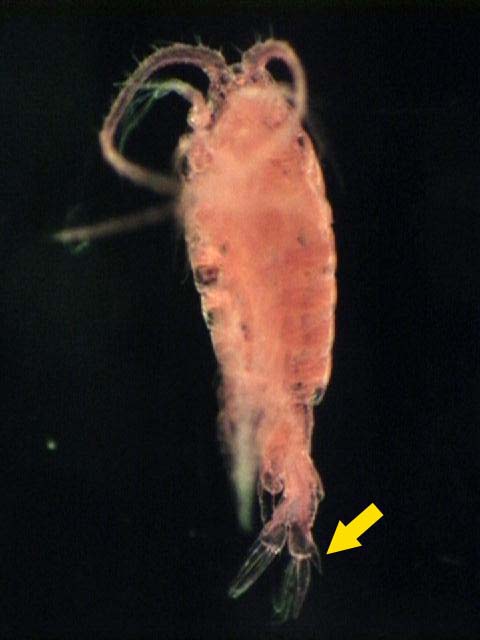|
Classification Kingdom - Animalia Introduction Epischura lacustris is a a large, omnivorous calanoid copepod that is the only Epischura species found in the Great Lakes region (Figure 1). E. lacustris was first discovered by S.A. Forbes in 1881 in Lake Michigan (Balcer et al. 1984). Anatomy Adult Epischura generally range in size from 1.8-2.0 mm for females and from 1.4-1.6 mm for males (Balcer et al. 1984). Long first antennae are used primarily for locomotion and reception (Figure 1; Figure 2). The second antennae and mouthparts are used to create currents for filtering food. Five pairs of thoracic legs are used mainly for swimming. Three stout setae on each caudal ramus differentiate Epischura from other calanoid copepods (Figure 3). Females are characterized by a twisted urosome and by large thick spines on the outer corner of the caudal rami. Males are recognized by a large lateral process on the right side of the urosome, by smaller outer spines on the caudal rami, and by a bent (geniculate) right antennule (Figure 4). The male's right antennule is used for grasping the female during copulation. Distribution E. lacustris is found throughout the more temperate regions of North America. E. lacustris is found in all of the Great Lakes, although in many locations it has become less abundant than it once was. Habitat E. lacustris typically resides in the near-shore region of deep, clear lakes (Balcer et al. 1984). During temperature stratification, E. lacustris is usually found in the upper part of the water column. When stratification is not present, it is often distributed throughout the entire water column. E. lacustris also vertically migrates towards the surface at night to feed (Balcer et al. 1984). Life History All calanoid copepods reproduce sexually (Balcer et al. 1984). Females drop their eggs after fertilization to overwinter on the lake bottom. Nauplii hatch in the spring and quickly develop through six naupliar and six copepodid stages into adults. Maturity is usually reached by late spring to early summer. In some lakes, two generations a year are produced, with the second naupliar hatch occurring during the summer months (Balcer et al. 1984). The reproductive rate of Epischura varies seasonally. Schulze and Folt (1990) in Lake Norford, Vermont, found that E. lacustris had a high reproductive rate during the spring months when adults began to mature and also during the autumn months. Conversely, the reproductive rate was much lower during the summer months due to reduced availability of prey items(Schulze and Folt 1990). Age, water temperature, and food availability are thought to be the primary factors influencing reproductive rate. Feeding Naupliar and early copepodid stages have an exclusively herbivorous diet (Chow-Frasier and Wong 1986). Adult Epischura are strong swimmers that feed on both algae and other zooplankton, including rotifers, cladocerans,and other copepods. Similiar to most omnivores, Epischura is classified as a "cruise and sink" forager (Schulze and Folt 1990). The frequency of predatory feeding increases throughout copepodid developmental stages. Adults have also been found to select Bosmina over other crustaceans as food items (Chow-Fraser and Wong 1986). |
Epischura lacustris 
Figure 1: Omnivorous calanoid copepod E. lacustris collected from Crystal Lake, Benzie Co., MI, on 7-25-98. 
Figure 2: Ventral view of E. lacustris. 
Figure 3: Closeup of the 3 broad terminal setae on each caudal ramus that distinguishes Epischura from other calanoid copepods.  
Figure 4: Comparison of female (left) and male (right) E. lacustris (-Note the broad spine on the outside corner of caudal ramus of the female and the geniculate right first antennule of the male). |
|
Works Cited Balcer, B.D., N.L. Korda, and S.I. Dodson. 1984. Zooplankton of the Great Lakes. The University of Wisconsin Press, Ltd. London, England. pp. 77-79. Chow-Fraser, P., and C.K. Wong. 1986. Dietary change during development in the freshwater calanoid copepod Epischura lacustris Forbes. Can. J. Fish. Aquat. Sci. 43: 938-944. Schulze, P.C.,and C.L. Folt. 1990. Food resources, survivorship, and reproduction of the omnivorous calanoid copepod Epischura lacustris. Ecology. 71: 2224-2240. |
